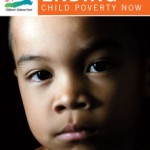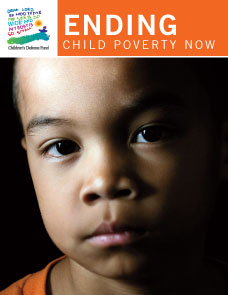
Poverty hurts children and our nation’s future. This stark statement is backed by years of scientific research and the more we learn about the brain and its development the more devastatingly true we know this to be. Childhood poverty can and does scar children for life. Yet in the largest economy on earth we stand by as 14.7 million languish in poverty. Here’s a snapshot of who our poor children are today: Every other baby is a child of color. And 1 in 2 Black babies is poor – the poorest child in America. 1 in 3 Hispanic children under 5 is poor during their years of …
Poverty hurts children and our nation’s future. This stark statement is backed by years of scientific research and the more we learn about the brain and its development the more devastatingly true we know this to be. Childhood poverty can and does scar children for life. Yet in the largest economy on earth we stand by as 14.7 million languish in poverty. Here’s a snapshot of who our poor children are today:
- Every other baby is a child of color. And 1 in 2 Black babies is poor – the poorest child in America.
- 1 in 3 Hispanic children under 5 is poor during their years of rapid brain development.
- More than 1 in 4 urban children and nearly 1 in 4 rural children is poor.
- 1 in 5 of all children in America is poor—14.7 million children.
- 1 in 6 Black children is extremely poor living on less than $8 a day.
- 1 in 7 Hispanic children under five is extremely poor.
- 1 in 8 Hispanic children is poor.
- Less than 1 in 9 White children is poor; 4.1 million children.
A child of color is more than twice as likely to be poor as a White child. Of the 14.7 million children living beneath the poverty line in 2013, defined as a family of four living on less than $23,834 a year, or $16.25 a person a day, over 40 percent lived in extreme poverty on less than $11,917 a year, half the poverty line – barely $8 a person a day.
The 14.7 million poor children in America exceeds the populations of 12 U.S. states combined: Alaska, Hawaii, Idaho, Maine, Montana, New Hampshire, North Dakota, Rhode Island, South Dakota, Vermont, West Virginia and Wyoming and is greater than the populations of Sweden and Costa Rica combined.
Our nearly 6.5 million extremely poor children exceeds the combined populations of Delaware, Montana, New Hampshire, Rhode Island, South Dakota, Vermont and Wyoming and is greater than the populations of Denmark or Finland.
It is a national disgrace that so many poor children live in the United States of America –the world’s richest economy. It doesn’t have to be this way. It’s costly. And it’s the greatest threat to our future national, economic and military security.

The Children’s Defense Fund has just released a groundbreaking report called Ending Child Poverty Now showing for the first time how America could end child poverty, as defined by the Supplemental Poverty measure, for 60 percent of all poor children and 72 percent of all poor Black children. We can make this happen by investing another 2 percent of the federal budget to improve existing programs and policies that increase parental employment, make work pay and ensure children’s basic needs are met. Poverty for children under 3 and children in single parent households would drop 64 percent and 97 percent of all poor children would experience improvements in their economic circumstances.
CDF contracted with the non-partisan, independent Urban Institute to generate real numbers on the costs to implement improvements to existing policies and programs and the number of children who would benefit. CDF’s report shows how relatively modest changes in policies we know work can be combined to significantly reduce child poverty, and implemented right now if our political leaders put common good, common sense and economic sense for children first to improve the lives and futures of millions of children, and save taxpayers hundreds of billions of dollars each year.
CDF’s report estimates a cost of $77.2 billion a year for the combined proposed policy improvements and suggests multiple tradeoffs our country can make to pay for this huge, long overdue and urgently needed reduction in child poverty without raising the federal deficit including:
- Closing tax loopholes that let U.S. corporations avoid $90 billion annually in federal income taxes by shifting profits to subsidiaries in foreign tax havens; or
- Eliminating tax breaks for the wealthy by taxing capital gains and dividends at the same rate as wages, saving more than $84 billion a year; or
- Scrapping the F-35 fighter jet program already several years behind schedule and 68 percent over budget and still not producing fully functioning planes. For the $1.5 trillion projected costs of this program, the nation could reduce child poverty 60 percent for 19 years, potentially breaking the cycle of intergenerational poverty.
Download CDF’s new report and share it widely with your child advocacy networks and faith communities to learn changes that can be made at the national, state and local levels. Fifty years after President Lyndon Johnson declared a war on poverty, it’s time for all Americans to work together to finish the job beginning with ending child poverty in our nation with the largest economy on earth.
Sign up for actions you can take for a real plan to end child poverty now.
This article is from:




















